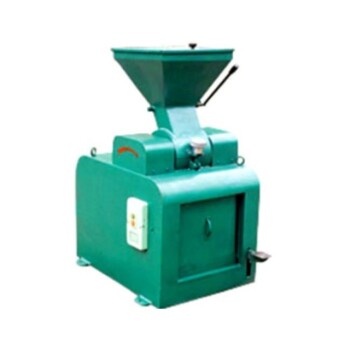At its most fundamental level, a ball mill is designed to produce a very fine powder from coarser materials. The typical product size achievable is exceptionally small, with final particle sizes often reaching 10 microns or less.
The primary function of a ball mill is particle size reduction through impact and attrition. While it can reliably produce powders in the micron range, the final product size is not a fixed number but a result of carefully controlling several operational variables.

How a Ball Mill Achieves Fine Grinding
A ball mill's effectiveness comes from a simple but powerful mechanical principle. Understanding this process is key to controlling the final particle size of your product.
The Core Grinding Mechanism
A hollow cylinder, partially filled with the material to be milled and a grinding media (usually steel or ceramic balls), rotates on a horizontal axis. As the cylinder turns, the balls are lifted up the side of the shell and then cascade or cataract down, crushing and grinding the material through impact and abrasion.
The Grinding Environment
This entire process occurs within a sealed container. This is why ball mills are exceptionally well-suited for grinding materials that are toxic or require a sterile environment, such as in the manufacturing of pharmaceuticals.
Key Factors That Determine Final Product Size
You can think of a ball mill not as a machine with a fixed output, but as an instrument. The final particle size is a direct result of how you "tune" its operational parameters.
Grinding Media
The characteristics of the balls themselves are critical. Larger, denser balls create higher impact forces, leading to faster size reduction. The material of the balls—ranging from steel to ceramic—is chosen based on the material being milled to avoid unwanted reactions or contamination.
Rotational Speed
The speed at which the cylinder rotates determines the action of the grinding media. Too slow, and the balls simply roll over each other (attrition). Too fast, and they are pinned to the shell by centrifugal force. The optimal speed creates a cascading motion that maximizes the impact energy for efficient grinding.
Milling Duration
There is a direct relationship between how long the mill runs and how fine the resulting powder becomes. Achieving a size of 10 microns or less often requires a significant amount of time, as the rate of size reduction slows as particles get smaller.
Material Characteristics
The inherent properties of the material being milled, such as its hardness and brittleness, will significantly influence the time and energy required to reach the desired particle size.
Understanding the Trade-offs
While highly effective, ball mills come with operational considerations that represent a trade-off between particle size, time, and cost.
Time vs. Fineness
Achieving an extremely fine particle size is not instantaneous. The relationship is one of diminishing returns; reducing particles from 50 to 20 microns may be relatively quick, but going from 20 to 10 microns can take substantially longer.
Energy Consumption
Breaking down materials to the micron level is an energy-intensive process. Long milling times required for very fine powders directly translate to higher energy costs, which is a critical factor in large-scale industrial applications.
Potential for Contamination
The constant impact and abrasion can cause microscopic wear on the grinding balls and the mill's inner lining. This can introduce trace amounts of the media or liner material into your final product, a crucial consideration for high-purity applications.
Making the Right Choice for Your Goal
Selecting or operating a ball mill requires matching its capabilities to your specific objective.
- If your primary focus is achieving a fine powder (≤ 10 microns): A ball mill is an excellent choice, provided you can accommodate the necessary milling time and energy use.
- If your primary focus is processing abrasive or toxic materials safely: The enclosed nature of a ball mill makes it one of the best and safest methods available.
- If your primary focus is speed and high throughput: You must balance this need against the desired fineness, as achieving the smallest particle sizes inherently requires longer processing cycles.
Ultimately, a ball mill offers you precise control over particle size reduction, making it an invaluable tool for creating highly refined materials.
Summary Table:
| Factor | Influence on Product Size |
|---|---|
| Grinding Media | Larger, denser balls create higher impact for faster size reduction. |
| Rotational Speed | Optimal speed creates a cascading motion for efficient grinding. |
| Milling Duration | Longer run times are required to achieve finer particle sizes (e.g., ≤10 microns). |
| Material Hardness | Harder, more brittle materials may require more time and energy to mill finely. |
Ready to achieve precise particle size reduction in your lab? KINTEK specializes in high-quality ball mills and lab equipment designed for reliability and fine grinding performance. Whether you're processing pharmaceuticals, chemicals, or other materials, our experts can help you select the right solution for your specific needs. Contact our team today to discuss how we can optimize your milling process!
Visual Guide

Related Products
- Laboratory Ball Mill Jar Mill with Metal Alloy Grinding Jar and Balls
- Stainless Steel Laboratory Ball Mill for Dry Powder and Liquid with Ceramic Polyurethane Lining
- Laboratory Single Horizontal Jar Mill
- Laboratory Four-Body Horizontal Jar Mill
- High-Energy Omnidirectional Planetary Ball Mill Milling Machine for Laboratory
People Also Ask
- What are the disadvantages of a ball mill? High Energy Use, Noise, and Contamination Risks
- What are the factors affecting grinding efficiency? Optimize Your Process for Maximum Output
- What is the preventive maintenance of ball mill? Ensure Maximum Uptime and Reliability
- What is the difference between a ball mill and a sag mill? A Guide to Primary vs. Secondary Grinding
- What is the purpose of ball milling? A Versatile Tool for Material Synthesis and Modification



















